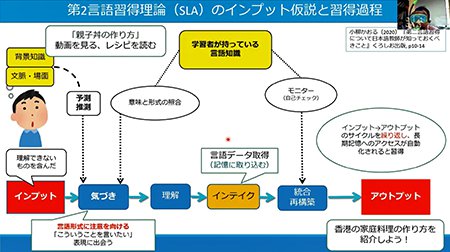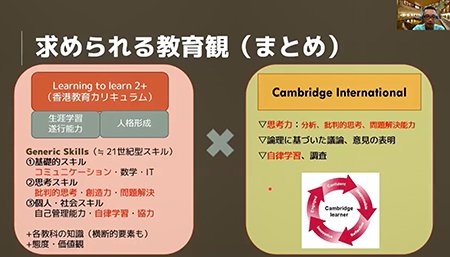A Record of the Trial-and-Error Process that was Followed in Shifting Japanese-Language Teacher Training Online (Hong Kong, 2020)
The Society of Japanese Language Education Hong Kong
SAITO Makoto
Like everything else, Japanese-language education in Hong Kong and Macau was significantly affected by the spread of COVID-19 from 2020 onward. The shift to online classes is said to have occurred relatively quickly and smoothly in Hong Kong compared to other countries. In this report, I would like to examine whether that was in fact the case, set out the sequence of events insofar as I witnessed them, and explain what types of support I implemented as a Japanese-Language Specialist.
Initial reports of the COVID-19 outbreak were surfacing throughout Hong Kong in December 2019. I had already begun to notice a large number of people wearing masks within the subway and so on prior to Christmas. On January 25, 2020 the government of Hong Kong lifted the infection warning level within the region to the highest warning tier, and announced that the Lunar New Year holiday scheduled to run at all schools in Hong Kong until January 28 would be extended.
It was initially thought that the holiday would be extended by around two or three weeks, but after COVID-19 spread around the world, the school closure measure was not lifted, and a move began emerging among some educational institutions to shift operations online. In Hong Kong, it is common to adopt an approach of trying something to begin with even if the preparations are not perfect, and then move ahead while making improvements accordingly. Conceivably, this is connected to the move to not halt students’ “learning.” I really struggled with what I could do to provide support in the midst of that. However, I felt that it would be important not only to not halt students’ learning, but to not halt the teachers’ learning (i.e. learning from one another) either. So to begin with, I decided to start by providing support to teachers not accustomed to web meetings. I began by trialing “introductory meetings” in a social media group of Japanese-language teachers in Hong Kong using a web meeting software at the end of February. Given that I myself had little to no online experience, I strove to become proficient while following a process of trial and error. From there, I held a study group on web meeting software and a webinar on online classes, as workshops hosted by the educational institution I am dispatched to.
With no sign of COVID-19 cases easing, the fiscal 2019–2020 Intensive Training Program for Japanese-Language Teachers, which had been suspended from February (refer also to my fiscal 2019 report), was shifted to an online format, and the period planned for mock classes, which had been scheduled for the second half (February–May), was shortened to April–May. These were held to the best extent that was possible at that time, and considering that this was a process of trial and error and was the first time anyone had attempted online classes, the level of satisfaction among the attendants was higher than I anticipated.

Fiscal 2019-2020 Intensive Training Program for Japanese-Language Teachers (held online)
In parallel to this, I held one-off workshops online. Once I attempted them, I discovered there were many aspects of an online format that appeared to offer advantages over in-person workshops, including the ease of sharing materials and resources and access to resources via the Internet, and the ability of participants to ask questions without hesitation by text. The number of people taking part from overseas also increased, and the interaction became active. I also received positive feedback from participants in the surveys I carried out after the workshops. On the other hand, the online format also means that when there is a large number of participants, the channels of conversation inevitably end up being limited, and it is not possible to create opportunities where participants can speak freely and make small talk. Nevertheless, I am coming up with solutions to the best of my ability, including leaving the online space open after an event ends and thereby creating a period when participants can talk freely amongst themselves.
On the basis of these experiences, when designing the course for the Intensive Training Program for Japanese-Language Teachers, which ran for more than eight months from September 2020, I assumed from the preparation stage that the seminar would be held entirely online. The seminar consists of a “theory section” for the first half and a “practice section” for the second half. For the latter “practice section” I had eight ordinary Japanese-language learners participate remotely. When I surveyed the learners after the seminar, they praised the online format, and in response to a question regarding the prospect of them taking classes in the future also, all the learners said they “would like to take classes online rather than in person.” On the other hand, when the attendants were also asked for their thoughts on the online format, opinion was divided, with around half responding that “in-person classes suit me.” In April 2021, I held training in an in-person format for the first time in a long time, which gave me the opportunity to get a real feel for the distinctive features of the online format and the in-person format, respectively.
During the shift to online classes I was very concerned about whether or not my support for teachers in Hong Kong and Macau was reaching the people who needed it. There are in fact some I did not reach, I believe. However, as far as I can tell, the teachers of Hong Kong and Macau are making great efforts to respond strongly and flexibly to the changing situation.
The coming era has become an era in which learners who had been learning in classrooms will select the class format that suits them – from in-person, online, a hybrid format and so on. Their teachers will likewise need to have the ability to respond flexibly. Also in teacher training, I view my own task as making proper use of online or in-person formats, depending on the themes and goals.

Society of Japanese Language Education Hong Kong’s monthly meeting (April 2021): “What is the HKDSE Japanese exam?”
- What We Do Top
- Arts and Cultural Exchange [Culture]
- Japanese-Language Education Overseas [Language]
- Japanese-Language Education Overseas [Language] Top
- Learn Japanese-language
- Teach Japanese-language
- Take Japanese-Language Test
- Know about Japanese-language education abroad
- The Japanese-Language Institute, Urawa
- The Japanese-Language Institute, Kansai
- Japanese-Language Programs for Foreign Specified Skilled Worker Candidates
- Japanese Language Education for Japanese Children Resident Overseas and for the Descendants of Migrants
- Archives
- Japanese Studies and Global Partnerships [Dialogue]
- JF digital collection
- Other Programs / Programs to Commemorate Exchange Year
- Awards and Prizes
- Publications
